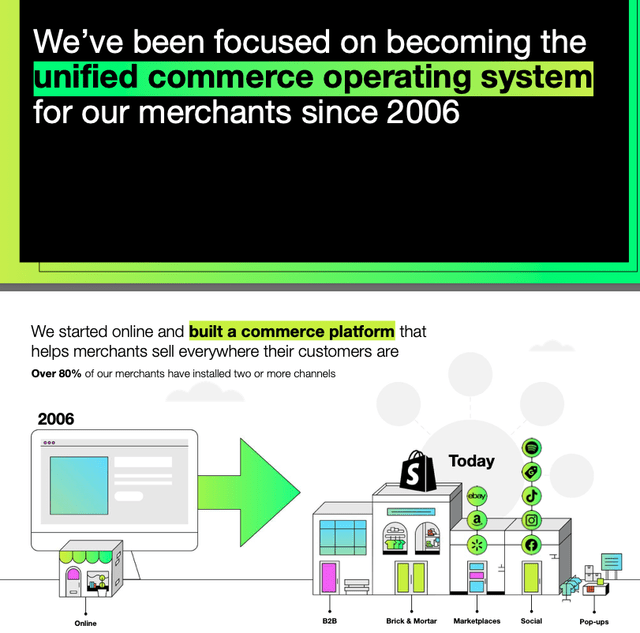JHVEPhoto
Last week I wrote about how fiscal discipline was in vogue at Shopify (NYSE:SHOP). On Thursday, the company reported earnings that showed this discipline in spades.
Estimates coming into the quarter were for non GAAP EPS of $0.14 and Free Cash Flow of roughly $200 Million. The company reported $0.24 EPS and FCF of $270 Million. Additionally the company guided to FCF in the high teens % of revenue for Q4, which equates to $370 Million to $400 Million for Q4 alone.
The Q3 + Q4 FCF should total $640 to $670 Million or roughly $1.3 Billion annualized. Given that Q4 is typically higher than all other quarters, it’s too simplistic to annualize these two quarters. One could say that you can annualize Q3 and then tack on Q4 as a one quarter phenomenon to arrive at $270 x 3 + $370 = $1.18 Billion FCF at the current run rate.
What is equally impressive is the revenue growth is still well above 20% and the revenue guidance for Q4 (+17%), when backing out Deliverr revenues, implies another at least low 20% revenue growth quarter. In a period with retail is struggling, it is quite clear that SHOP is taking significant market share.
On top of this, margins are expanding.
Analyst Estimates Need to Go Up Significantly
Let’s take a look at the estimates for 2024 and 2025 for SHOP. Here are the adjusted EPS figures for 2024 and 2025:

EPS Guidance for Shopify (Koyfin)
2024: $0.96
2025: $1.25
Shopify just reported $0.24 for Q3 and guidance implies $0.32 EPS. That is, in the 2nd half of 2023, SHOP will likely do about $0.56 to $0.60 EPS and the full year 2024 analyst estimates are at $0.96.
By my guess, SHOP will come in at $1.20 to $1.35 EPS for 2024, assuming they are in the range of Q4 guided FCF margins of 18.5% to as high as 20.5%. Additionally, I see SHOP doing $1.50 to $1.80 EPS in 2025.
Here are the estimates for FCF for 2024 and 2025:

Shopify FCF Estimates (Koyfin)
2024: $1.117 Billion
2025: $1.471 Billion
As noted above, SHOP is currently on a run rate of $1.17 Billion FCF. With revenues expected to grow about 20% in 2024, if they just maintained current FCF margins, they would come in at $1.4 Billion for 2024 and $1.68 Billion for 2025.
However, margins are expanding dramatically. FCF margins have expanded from 5.2% in Q4 2022 to 16.1% in Q3 2023, a 1090bp improvement. The company is seeing significant scales of economy.
My estimates are now that SHOP will come in at FCF of $1.5 Billion to $1.7 Billion for 2024 and $1.85 to $2.1 Billion in 2025.
Valuation
At current levels ($60/share, $77 Billion), SHOP is trading at the following multiples:
P/E 2024 (my mid point estimates): 47X
P/E 2025 (my mid point estimates): 36X
P/FCF (’24 – my estimates): 48X
P/FCF (’25 – my estimates): 39X
While these are premium multiples, they’re right in line with early compounders like Salesforce (CRM), Amazon (AMZN), and others in the tech and e-commerce space.
CRM traded at a P/FCF multiple of 37 to 70 from 2010 to 2020 when it was growing at similar rates as SHOP. AMZN traded at a P/FCF of 35 to 100 from 2011 to 2020, also during a period when it was growing at similar rates as SHOP.
At top line growth rates of 20%+ and expanding margins, its fairly easy to see SHOP growing at CAGR’s north of 20% for the rest of the decade.
Refocused and Invigorated
There are roughly 2.1 Million active users of Shopify currently. With a worldwide pool of over 400 Million businesses, SHOP is currently only penetrating 0.5% of the addressable market. If we narrow the addressable market down to just Europe (24.4 Million businesses), USA (33 Million small businesses), Canada (1.3 Million) and Australia (2.6 Million), that’s a total of 61 million businesses, of which SHOP has only a 3.4% penetration rate.
This of course excludes India, SE Asia, Latin American, South America, and Africa, all of whom are growing users of Shopify.
President Harley Finkelstein spoke to the faster, leaner business model of Shopify on CNBC last week and you can tell how excited and invigorated they are now that they’re back to an asset light business model with the logistics arm out of the way.
The company’s goal is to be the operating system for unified commerce (i.e., e-commerce and offline commerce (think Shop GO retail POS systems) and recent moves into taxes, bill payments and more shows that SHOP has ambitions to grow its foothold within each business and capture more and more of the total spend on software tools that make these businesses more efficient.

Shopify Operating System Ambitions (Shopify)
With what is likely less than a 1% market share of their addressable market of businesses worldwide and a similar small fraction of the total spend of each business on their software operating tools, SHOP has the potential to grow substantially for about as far as the eye can see.
Shopify is truly one of those remarkable companies that only come around so often and the real difficulty will likely be to hold on to it for as long as you possibly can and while the stock continues to compound.
















